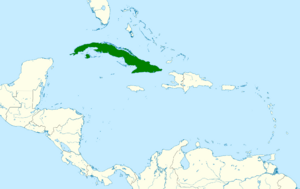Cuban martin facts for kids
Quick facts for kids Cuban martin |
|
|---|---|
 |
|
| In Havana, Cuba | |
| Conservation status | |
| Scientific classification | |
| Genus: |
Progne
|
| Species: |
cryptoleuca
|
 |
|
The Cuban martin (Progne cryptoleuca) is a large swallow that lives only in Cuba. It is a special bird because it is endemic to Cuba, meaning it is found nowhere else naturally.
This bird is closely related to the Caribbean martin and the Sinaloa martin. Scientists have sometimes thought it might be a type of purple martin.
Contents
What Does the Cuban Martin Look Like?
Adult Cuban martins are about 18.5 cm (7.3 inches) long. They have a forked tail and wide wings. They weigh about 40 g (1.4 ounces).
Male Cuban martins are shiny blue-black. Their lower belly is a bright white. Females and young birds are not as colorful. They have a grey-brown chest and sides, with white lower parts.
How to Tell Them Apart from Other Martins
It can be tricky to tell Cuban martins from other similar birds.
- Cuban vs. Caribbean Martin: Adult male Cuban martins have dark bellies. Caribbean martins have a clear white patch on their belly. It's harder to tell the females and young birds apart.
- Cuban vs. Purple Martin: Adult male Cuban and Purple martins look very similar. It's hard to tell them apart just by looking. However, female and young Purple martins have a scaly pattern on their chest. This helps tell them apart from Cuban martins.
Unlike the Purple and Caribbean martins, the Cuban martin lives only in Cuba and Isla de la Juventud. Purple and Caribbean martins visit Cuba only during the winter months.
What Do Cuban Martins Do?
Cuban martins are social birds. They often fly together in groups, sometimes with other types of birds. They hunt for insects while flying. Their call sounds like a gurgly chew-chew.
Nesting and Raising Young
Cuban martins build their nests in holes. They might use holes in riverbanks or buildings. They also like old woodpecker holes. These are often found in coconut trees in the countryside.
A female Cuban martin lays 3 to 6 eggs. She sits on the eggs for about 15 days until they hatch. After hatching, the young birds stay in the nest for another 26 to 27 days before they can fly.
Cuban martins sometimes have to compete for nesting spots. In cities, they often compete with house sparrows. In the countryside, where they use woodpecker holes, there is less competition.
Where Else Are They Seen?
Even though Cuban martins are mostly found in Cuba, a few have been seen in Florida. These are called "vagrants" because they have wandered outside their usual home.


